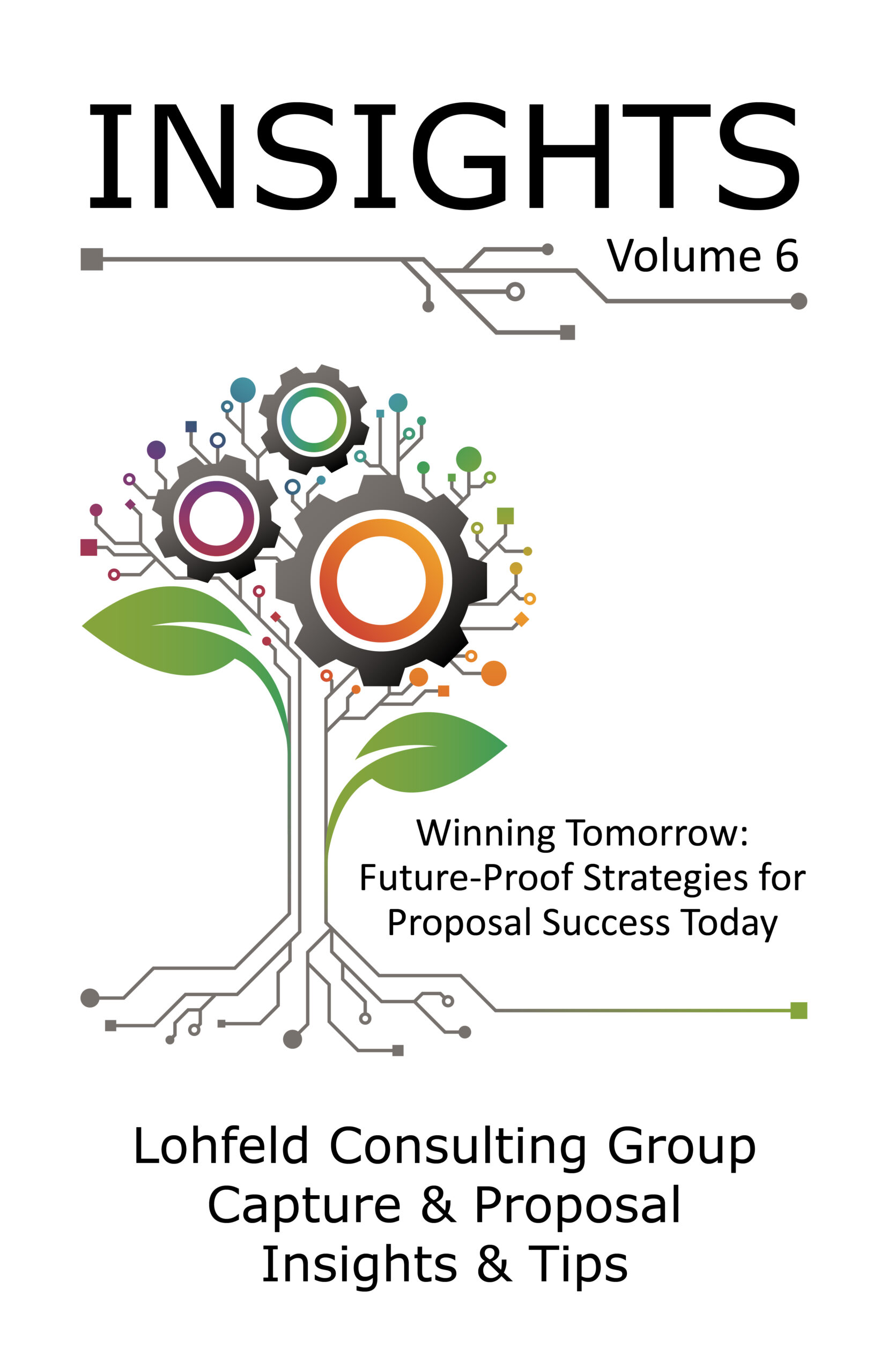25-Point Checklist: Secure Proposal Writing Success Now

Boost your confidence in proposal writing with Lohfeld Consulting’s 25-point checklist of best practices. A well-crafted proposal communicates your values and distinguishes you from competitors. Inspired by Lohfeld Consulting’s expertise, this checklist offers actionable steps to refine your proposal writing skills and enhance your chances of winning bids. We organized the 25-point checklist items into five groups: 1) planning, 2) strategy, 3) solution development, 4) review, communications, and editing, and 5) workflow and efficiency.
Planning Tasks
#1 Plan Your Writing: Don’t rush. Gather the necessary information to craft a compelling proposal. If needed, organize data calls to collect persuasive details. Use this information to plan each proposal section, employing content plans as necessary.
#2 Verify Compliance: Carefully review the RFP to ensure all requirements are met. Use an approved compliance matrix and outline to guide your writing. The compliance matrix should map the RFP to your proposal sections, while the outline lists instructions, evaluation criteria, requirements, page limits, and other guidance.
#3 Design Your Response: Design pages before writing. Use headlines, tables, charts, diagrams, text boxes, bolding, and italics to emphasize your solution’s benefits. Aim to insert one visual on each page.
#4 Plan for a Strong Conclusion: Reinforce your proposal’s strengths with a convincing summary of why the customer should award you the contract.
Writing Strategy Tasks
#5 Focus on Your Client: Center your proposal on the customer, not your company. Emphasize understanding their requirements and how your solution meets them. Mention the customer twice as much as your company.
#6 Emphasize Responsiveness: Describe how you will perform the work in as much detail as possible. Describe relevant assignment, compliance, methodology, risk mitigation, communications, quality control, and reporting processes.
#7 Demonstrate Your Value Proposition: Clearly define why your solution offers the best value. Ensure that your value proposition is specific, measurable, achievable, relevant, and time-bound.
#8 Craft High-Scoring Sections: Show yourunderstanding of the customer’s requirements and align that understanding with your solution. Explain how your solution meets or exceeds these requirements, enhancing contract success and mitigating risks.
#9 Focus on Strengths, Not Just Features: Explain how each feature benefits the client. Use data to demonstrate potential outcomes, ensuring strengths are unique to your company.
Solution Development Writing Tasks
#10 Tell Compelling Stories: Use storytelling to connect emotionally with evaluators. Use real-life examples and case studies to illustrate your solution’s effectiveness and reliability.
#11 Incorporate Risk Management Strategies: Address potential risks and propose mitigation strategies. Increase the customer’s confidence by showing that you have considered all angles and are prepared to handle challenges.
#12 Offer Innovative Ideas: Propose creative solutions that differentiate your proposal from competitors. Demonstrate your organization’s ability to think outside the box.
#13 Highlight Team Expertise: Build credibility by highlighting team qualifications. Tailor resumes to demonstrate how your team members meet and exceed RFP requirements. Describe how they overcame challenges and used lessons learned to improve operations.
#14 Integrate Quality Measures: Explain how you will ensure quality outcomes. Identify measurements to verify how well you will perform the work and how you will provide the customer with objective data to report your results.
#15 Use Past Performance: Include examples of past successes relevant to the current proposal. Use past performance to build confidence in your ability to deliver.
#16 Use Testimonials and Endorsements: Build credibility and trust by including testimonials and endorsements from satisfied clients. Showcase awards or recognitions your company received.
#17 Anticipate Questions and Objections: Anticipate potential questions or objections from evaluators and address them. Offer clear and concise responses to potential concerns, demonstrating thorough preparation.
Review, Communication, and Editing Tasks
#18 Seek Feedback and Revise: Encourage team members to provide feedback and collaboratively refine the proposal for clarity and impact. Use feedback to make iterative adjustments to improve the proposal’s score.
#19 Use Clear and Concise Language: Use accessible language, stating points clearly without embellishments. Each sentence should advance your argument.
#20 Use Active Voice: Write in an active voice for directness and clarity. Break up text with headings and bullet points for easy scanning.
#21 Maintain a Consistent Tone: Ensure cohesion and professionalism with a consistent tone and style throughout the proposal. Align the tone with the customer’s values.
#22 Edit and Proofread Thoroughly: Conduct multiple proofreading rounds and use tools to catch errors. Have colleagues review for fresh perspectives.
#23 Optimize for Digital Submission: Format your proposal for easy digital submission and readability on various devices. As permitted, include hyperlinks for easy navigation.
Workflow and Efficiency Tasks
#24 Use AI as Appropriate: Implement AI to streamline the writing tasks. While AI can’t write a proposal section, it can help conduct research, present first-draft ideas, and edit.
#25 Frequent Meetings: Review writing outputs frequently. Check in with team members to ensure they have what they need to stay on schedule.
Conclusion
By integrating these techniques into your proposal writing process, you can create submissions that are clear, compelling, and strategically aligned with client needs. Implementing these best practices will help you to produce winning proposals that stand out in a crowded field. Remember, each proposal is an opportunity to showcase your expertise and value, unlocking success in the competitive world of government contracting.
Relevant Information
By Brenda Crist, Vice President at Lohfeld Consulting Group, MPA, CPP APMP Fellow
Lohfeld Consulting Group has proven results specializing in helping companies create winning captures and proposals. As the premier capture and proposal services consulting firm focused exclusively on government markets, we provide expert assistance to government contractors in Capture Planning and Strategy, Proposal Management and Writing, Capture and Proposal Process and Infrastructure, and Training. In the last 3 years, we’ve supported over 550 proposals winning more than $170B for our clients—including the Top 10 government contractors. Lohfeld Consulting Group is your “go-to” capture and proposal source! Start winning by contacting us at www.lohfeldconsulting.com and join us on LinkedIn, Facebook, and YouTube(TM).
Paperback or Kindle
10 steps to creating high-scoring proposals
by Bob Lohfeld
contributors Edited by Beth Wingate
Subscribe to our free ebrief
Teaming friends, frenemies, and enemies—12 tips to mitigate harmful effects
Did you know that contracting officers spend up to 20% of their time mitigating disputes between teaming partners? In an informal poll we conducted on LinkedIn last month, 40% of respondents classified their teaming partners as “frenemies” on their last bid.
Explore Further
- Advice (539)
- AI (28)
- APMP (18)
- Army MAPS Contracts (3)
- Business Development (294)
- Capture Management (266)
- Complex Technology Grants Services (26)
- Favorite Books (5)
- GenAI (4)
- Go-to-Market (27)
- Graphics (5)
- Lohfeld Books (2)
- NASA SEWP VI Contracts (2)
- Navy SeaPort-NxG Contracts (2)
- NIST MSE Grants (1)
- NIST NAPMP Grants (2)
- Past Performance (63)
- Post-submission Phase (14)
- Pre-RFP Preparation (264)
- Proposal Management (339)
- Proposal Production (75)
- Proposal Reviews (38)
- Proposal Writing (107)
- Pursuit Phase (108)
- Research Report (4)
- Resources (63)
- Tools & Tips (421)
- Training (13)
- Uncategorized (223)

Sign Up for INSIGHTS and Download your FREE book
We'd love to help you with your proposals. Enjoy our complimentary Lohfeld Consulting Group Capture & Proposal Insights & Tips book with your FREE subscription to our Insights Newsletter.
GET YOUR FREE BOOK



